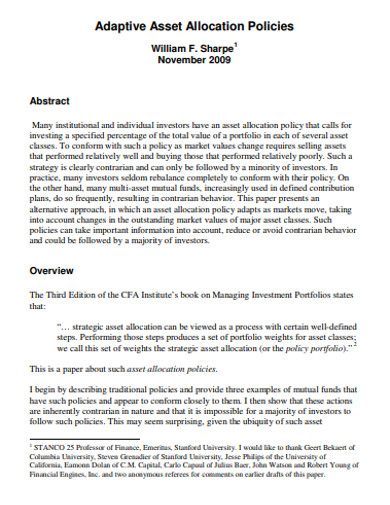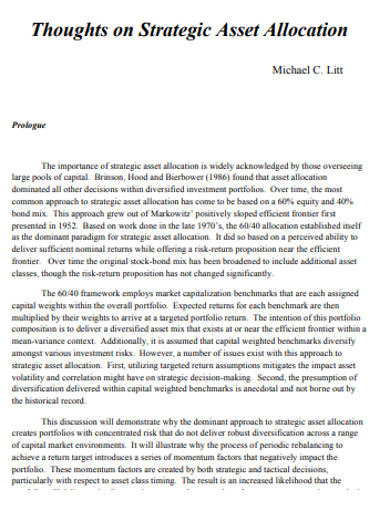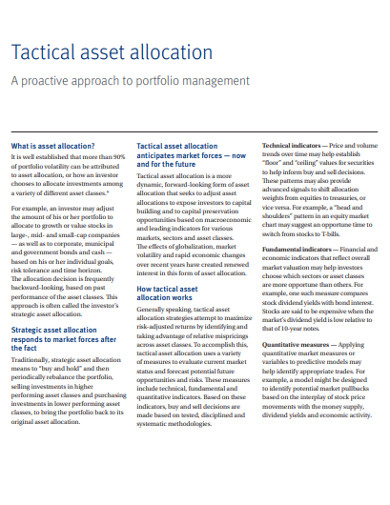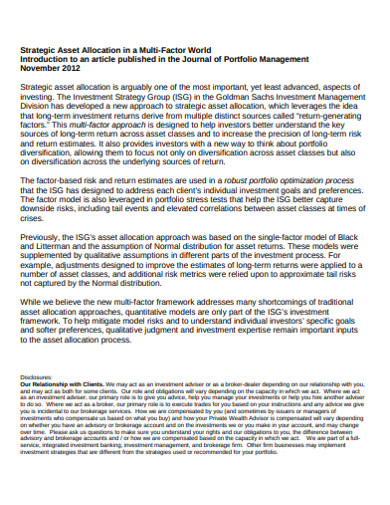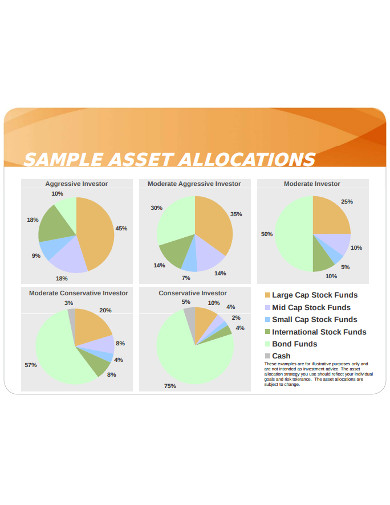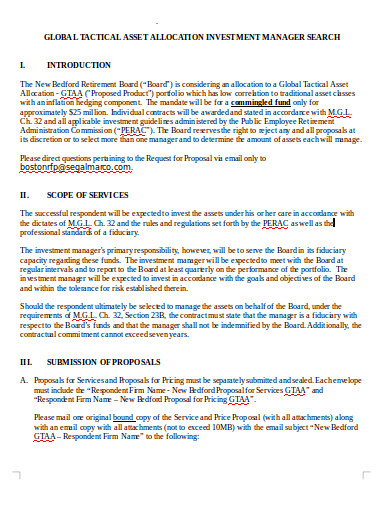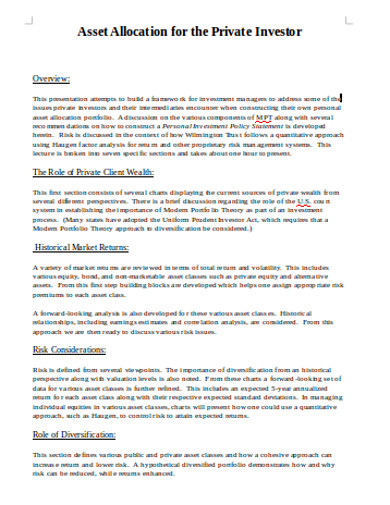8+ Asset Allocation Examples to Download
Asset allocation is one of the crucial determining factors of a portfolio’s success and triumph. It diversifies a portfolio that gives the investor a large amount of return with the least risk over a period. Here in this article, we have provided some asset allocation examples that will give you a better understanding of asset allocation and the things that are linked with it.
8+ Asset Allocation Examples in PDF | DOC
1. Asset Allocation Policies Example
2. Asset Allocation and Risk Management Example
3. Asset Allocation Experiment Example
4. Strategic Asset Allocation Example
5. Tactical Asset Allocation Example
6. Basic Asset Allocation Example
7. Sample Asset Allocation Example
8. Global Tactical Asset Allocation Example
9. Asset Allocation for the Private Investor Example
Asset Allocation
Asset allocation is one of the investment strategies. It intends to balance the risk and rewards by distributing a portfolio’s assets in accordance with the goals, investment horizon, and risk tolerance of an individual. The three mentioned factors are all corporate finance essentials. However, the last factor also takes part in financial risk management.
Fixed Asset Allocation
Fixed assets are resources bought for business purposes that have long-term worth. For small companies, this type of asset is an essential resource that expresses a large part of the net worth taken on the balance sheet. It should be recorded, maintained, and reconciled to get an accurate valuation of a business or spot-on tax reporting. Examples of fixed assets are lands, furniture, buildings, etc.
When a business obtains or dismisses a fixed asset, it will be put on the CF statement — also known as cash flow statement — under the cash flow from investing activities. The fixed asset purchase signifies a company’s cash outflow. A fixed asset sale, on the other hand, represents a cash inflow.
Asset Allocation Strategies
It is undeniable that asset allocation is a crucial part of making and balancing the investment portfolio. Thus, we have accumulated various and substantial strategies for your asset allocation establishment:
- Strategic Asset Allocation – This method introduces and sticks to a base policy mix — it is the proportional mixture of assets based on the anticipated return rates for every asset class. Moreover, it sets goals and asks for some rebalancing every once in a while. It may be affiliated with the buy-and-hold strategy and strongly suggests diversification to trim back on risk and upgrade returns.
- Constant-Weighing Asset Allocation – This approach lets you constantly rebalance your portfolio. For instance, if an asset falls in value, you have to buy more of that particular asset. However, if the said asset increases in value, you will have to sell it. The main rule is that the portfolio must be balanced again into its premier mix when any given asset class creates a movement that is 5 percent higher from its primary value.
- Tactical Asset Allocation – This is a relatively active strategy. It is because the total strategic asset mix is restored to when the wanted short-term profits are attained. Furthermore, this strategy requires some discipline because you must first acknowledge and recognize when short-term chances have started their line and rebalance the portfolio to a long-term position of the asset. In your portfolio, the asset mix must reflect your targets at any moment.
- Dynamic Asset Allocation – It is all about the constant adjustment of the asset mix as the economy weakens and strengthens, and as the markets go up and down. With this approach, you sell an asset that decreases, and you can also buy an asset that strengthens. Moreover, this strategy relies significantly on the judgment of the portfolio manager instead of the target asset mix.
- Insured Asset Allocation – This strategy helps you establish a base portfolio value whereby the said portfolio should not be permitted to drop. If the portfolio attains a return higher than its base, you practice active management and get to decide which securities to purchase, hold, and sell to raise the portfolio value whenever possible.
- Integrated Asset Allocation – In this method, you need to take into account your economic aspirations and your risk in the asset mix establishment. It is because this strategy comprises the factors of all the recently discussed strategies. This strategy considers not only expectations but also for the real changes occurring in the capital markets and your tolerance to risk. Thus, it is a broader strategy. However, it cannot comprise the dynamic allocation, and the constant-weighting allocation as well since investors don’t hope to implement two competing approaches.
How Asset Allocation Works
Asset allocation is all about distributing an investment portfolio into asset categories. The said categories include stocks, bonds, and cash. Every class of assets contains varying levels of risk and return; thus, every type behaves distinctly over a period. For example, while a particular asset category’s value is increasing, another may be declining or not progressing as much as the specific category. Some critics view this balance as a method for mediocre returns. For most investors, on the other hand, it is the most excellent protection when it comes to a significant loss.
The asset allocation that functions best for you greatly depends on your time horizon and risk tolerance ability. Therefore, you must be an expert when it comes to financial risk management and advanced financial management as well.
Types of Asset Allocation
There are different classes of asset allocation, and each class carries distinct levels of reward and risk. Thus, here are the major types of asset allocation every business owner or finance professional needs to know:
1. Cash – This category has the lowest chances of losing money on an investment. In other words, this is the least risky and safest option. However, once you have extracted the cost of inflation, the return is negative. Certificates of deposit, money market funds, and savings deposits belong in this category.
2. Bond – Bonds are typically less uncertain than stocks but offer more simple returns. There are several kinds of bonds; however, all of them are fixed-income investments. The safest type is the U.S Treasury bonds because the federal government has 100% guaranteed them, and they offer a little higher return compared to cash. Moreover, state and municipal bonds provide a somewhat bigger risk and reward. Corporate bonds offer a larger return; however, it also has a greater risk of failure.
3. Stocks – Stocks generally carry the highest risk and greatest returns. They are considered as a portfolio’s major player because it offers the biggest shot or possibility for growth. It can hit your target with the bullseye, but it can also take you down. Thus, the unstableness of stocks them the riskiest investment.
Aside from the three major categories that are mentioned above, here are the other types that you also need to consider:
1. Real Estate – This comprises your home equity, which almost all financial advisers don’t consider because you are living in it. However, the worth could degenerate. You can lose every bit of your investment if you tend to foreclose.
2. Derivatives – These give the greatest returns and risk. It is because you can lose more than what you have invested. Some examples are collateralized debt, market neutral strategies, futures, and options.
3. Commodities – There is a wide array of risks since there are a lot of kinds of commodities. These hard assets range from wheat to gold and oil. In business, it is any product or service that is purchased and sold absolutely on price. The majority of investors must own some shares of oil-related mutual funds. Moreover, it should increase over the long period as supplies decreases. As an investor, you should have not more than 10% gold allocation.
4. Currencies – It is advantageous and beneficial to have assets expressed in foreign currencies because it can save and protect you against the decrease in the dollar. For instance, when your current currency — the dollar — is declining, then you can expect that the other foreign currency such as the euro is increasing in value.
Importance of Asset Allocation
For professionals in the field of finance, asset allocation is a crucial decision that every investor creates. Investors may utilize various asset allocations for different goals and purposes. Thus, one must be proficient when it comes to corporate financial management and most especially, asset allocation. Furthermore, it is vital because it creates a big impact on meeting your financial targets.
For instance, someone who is saving for a new house in the next following years might invest her savings fund in an extremely conservative cash mix, CDs — also known as certificates of cash deposits — and bonds that are short-termed.
Moreover, another person saving for future retirement basically invests a large portion of his IRA or individual retirement account in stocks, for he has much time to pull through the short-term fluctuations of the market. Thus, risk tolerance also plays a vital role in this phase. An individual that is ill at ease in investing in stocks may put her fund in a much conservative allocation despite the long-term horizon.
The Connection Between Asset Allocation and Diversification
Diversification comprises distributing the money among different investments and wishing that if there is a loss in one investment, the other investments will make up for the said loss in a better way. A lot of investors utilize asset allocation as a method to diversify their investments within asset categories.



